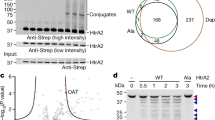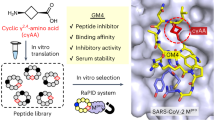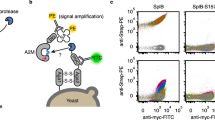Abstract
Many biologically and chemically based approaches have been developed to design highly active and selective protease substrates and probes. It is, however, difficult to find substrate sequences that are truly selective for any given protease, as different proteases can demonstrate a great deal of overlap in substrate specificities. In some cases, better enzyme selectivity can be achieved using peptide libraries containing unnatural amino acids such as the hybrid combinatorial substrate library (HyCoSuL), which uses both natural and unnatural amino acids. HyCoSuL is a combinatorial library of tetrapeptides containing amino acid mixtures at the P4–P2 positions, a fixed amino acid at the P1 position, and an ACC (7-amino-4-carbamoylmethylcoumarin) fluorescent tag occupying the P1′ position. Once the peptide is recognized and cleaved by a protease, the ACC is released and produces a readable fluorescence signal. Here, we describe the synthesis and screening of HyCoSuL for human caspases and legumain. We also discuss possible modifications and adaptations of this approach that make it a useful tool for developing highly active and selective reagents for a wide variety of proteolytic enzymes. The protocol can be divided into three major parts: (i) solid-phase synthesis of the fluorescence-labeled HyCoSuL, (ii) screening of protease P4–P2 preferences, and (iii) synthesis of the optimized activity probes equipped with an AOMK (acyloxymethyl ketone) reactive group and a biotin label for easy detection. Beginning with the library design, the entire protocol can be completed in 4–8 weeks (HyCoSuL synthesis: 3–5 weeks; HyCoSuL screening per enzyme: 4–8 d; and activity-based probe synthesis: 1–2 weeks).
This is a preview of subscription content, access via your institution
Access options
Access Nature and 54 other Nature Portfolio journals
Get Nature+, our best-value online-access subscription
$29.99 / 30 days
cancel any time
Subscribe to this journal
Receive 12 print issues and online access
$259.00 per year
only $21.58 per issue
Buy this article
- Purchase on Springer Link
- Instant access to full article PDF
Prices may be subject to local taxes which are calculated during checkout








Similar content being viewed by others
References
Drag, M. & Salvesen, G.S. Emerging principles in protease-based drug discovery. Nat. Rev. Drug Discov. 9, 690–701 (2010).
Turk, B. Targeting proteases: successes, failures and future prospects. Nat. Rev. Drug Discov. 5, 785–799 (2006).
Rawlings, N.D., Barrett, A.J. & Finn, R. Twenty years of the MEROPS database of proteolytic enzymes, their substrates and inhibitors. Nucleic Acids Res. 44, D343–D350 (2016).
Schechter, I. & Berger, A. On the size of the active site in proteases. I. Papain. Biochem. Biophys. Res. Commun. 27, 157–162 (1967).
Lopez-Otin, C. & Overall, C.M. Protease degradomics: a new challenge for proteomics. Nat. Rev. Mol. Cell Biol. 3, 509–519 (2002).
Grootjans, S. et al. A real-time fluorometric method for the simultaneous detection of cell death type and rate. Nat. Protoc. 11, 1444–1454 (2016).
Poreba, M. & Drag, M. Current strategies for probing substrate specificity of proteases. Curr. Med. Chem. 17, 3968–3995 (2010).
Kasperkiewicz, P., Poreba, M., Groborz, K. & Drag, M. Emerging challenges in the design of selective substrates, inhibitors and activity-based probes for indistinguishable proteases. FEBS J. 284, 1518–1539 (2017).
Diamond, S.L. Methods for mapping protease specificity. Curr. Opin. Chem. Biol. 11, 46–51 (2007).
Matthews, D.J. & Wells, J.A. Substrate phage: selection of protease substrates by monovalent phage display. Science 260, 1113–1117 (1993).
Thornberry, N.A. et al. A combinatorial approach defines specificities of members of the caspase family and granzyme B. Functional relationships established for key mediators of apoptosis. J. Biol. Chem. 272, 17907–17911 (1997).
Harris, J.L. et al. Rapid and general profiling of protease specificity by using combinatorial fluorogenic substrate libraries. Proc. Natl. Acad. Sci. USA 97, 7754–7759 (2000).
McStay, G.P., Salvesen, G.S. & Green, D.R. Overlapping cleavage motif selectivity of caspases: implications for analysis of apoptotic pathways. Cell Death Differ. 15, 322–331 (2008).
Choe, Y. et al. Substrate profiling of cysteine proteases using a combinatorial peptide library identifies functionally unique specificities. J. Biol. Chem. 281, 12824–12832 (2006).
Drag, M. et al. Positional-scanning fluorigenic substrate libraries reveal unexpected specificity determinants of DUBs (deubiquitinating enzymes). Biochem. J. 415, 367–375 (2008).
Powers, J.C., Asgian, J.L., Ekici, O.D. & James, K.E. Irreversible inhibitors of serine, cysteine, and threonine proteases. Chem. Rev. 102, 4639–4750 (2002).
Withana, N.P. et al. Labeling of active proteases in fresh-frozen tissues by topical application of quenched activity-based probes. Nat. Protoc. 11, 184–191 (2016).
Oresic Bender, K. et al. Design of a highly selective quenched activity-based probe and its application in dual color imaging studies of cathepsin S activity localization. J. Am. Chem. Soc. 137, 4771–4777 (2015).
Kasperkiewicz, P. et al. Design of ultrasensitive probes for human neutrophil elastase through hybrid combinatorial substrate library profiling. Proc. Natl. Acad. Sci. USA 111, 2518–2523 (2014).
Kasperkiewicz, P., Gajda, A.D. & Drag, M. Current and prospective applications of non-proteinogenic amino acids in profiling of proteases substrate specificity. Biol. Chem. 393, 843–851 (2012).
Rut, W. et al. Recent advances and concepts in substrate specificity determination of proteases using tailored libraries of fluorogenic substrates with unnatural amino acids. Biol. Chem. 396, 329–337 (2015).
Rano, T.A. et al. A combinatorial approach for determining protease specificities: application to interleukin-1beta converting enzyme (ICE). Chem. Biol. 4, 149–155 (1997).
Poreba, M. et al. Unnatural amino acids increase sensitivity and provide for the design of highly selective caspase substrates. Cell Death Differ. 21, 1482–1492 (2014).
Ostresh, J.M., Winkle, J.H., Hamashin, V.T. & Houghten, R.A. Peptide libraries: determination of relative reaction rates of protected amino acids in competitive couplings. Biopolymers 34, 1681–1689 (1994).
Denault, J.B. & Salvesen, G.S. Caspases: keys in the ignition of cell death. Chem. Rev. 102, 4489–4500 (2002).
Aglietti, R.A. & Dueber, E.C. Recent insights into the molecular mechanisms underlying pyroptosis and gasdermin family functions. Trends Immunol. 38, 261–271 (2017).
Dall, E. & Brandstetter, H. Structure and function of legumain in health and disease. Biochimie 122, 126–150 (2016).
Poreba, M. et al. Counter selection substrate library strategy for developing specific protease substrates and probes. Cell Chem. Biol. 23, 1023–1035 (2016).
Rut, W. et al. Extended substrate specificity and first potent irreversible inhibitor/activity-based probe design for Zika virus NS2B-NS3 protease. Antiviral Res. 139, 88–94 (2017).
Kasperkiewicz, P. et al. Design of a selective substrate and activity based probe for human neutrophil serine protease 4. PLoS One 10, e0132818 (2015).
Lentz, C.S. et al. Design of selective substrates and activity-based probes for hydrolase important for pathogenesis 1 (HIP1) from Mycobacterium tuberculosis. ACS Infect. Dis. 2, 807–815 (2016).
Schneider, E.L. & Craik, C.S. Positional scanning synthetic combinatorial libraries for substrate profiling. Methods Mol. Biol. 539, 59–78 (2009).
Lechtenberg, B.C., Kasperkiewicz, P., Robinson, H., Drag, M. & Riedl, S.J. The elastase-PK101 structure: mechanism of an ultrasensitive activity-based probe revealed. ACS Chem. Biol. 10, 945–951 (2015).
Smith, G.P. Filamentous fusion phage: novel expression vectors that display cloned antigens on the virion surface. Science 228, 1315–1317 (1985).
Legowska, M. et al. Ultrasensitive internally quenched substrates of human cathepsin L. Anal. Biochem. 466, 30–37 (2014).
Gosalia, D.N., Denney, W.S., Salisbury, C.M., Ellman, J.A. & Diamond, S.L. Functional phenotyping of human plasma using a 361-fluorogenic substrate biosensing microarray. Biotechnol. Bioeng. 94, 1099–1110 (2006).
Vizovisek, M., Vidmar, R., Fonovic, M. & Turk, B. Current trends and challenges in proteomic identification of protease substrates. Biochimie 122, 77–87 (2016).
Schilling, O. & Overall, C.M. Proteomic discovery of protease substrates. Curr. Opin. Chem. Biol. 11, 36–45 (2007).
Staes, A. et al. Selecting protein N-terminal peptides by combined fractional diagonal chromatography. Nat. Protoc. 6, 1130–1141 (2011).
Korkmaz, B., Horwitz, M.S., Jenne, D.E. & Gauthier, F. Neutrophil elastase, proteinase 3, and cathepsin G as therapeutic targets in human diseases. Pharmacol. Rev. 62, 726–759 (2010).
Janicke, R.U., Sohn, D., Totzke, G. & Schulze-Osthoff, K. Caspase-10 in mouse or not? Science 312, 1874 (2006).
Berger, A.B., Sexton, K.B. & Bogyo, M. Commonly used caspase inhibitors designed based on substrate specificity profiles lack selectivity. Cell Res. 16, 961–963 (2006).
Pereira, N.A. & Song, Z. Some commonly used caspase substrates and inhibitors lack the specificity required to monitor individual caspase activity. Biochem. Biophys. Res. Commun. 377, 873–877 (2008).
Drag, M., Bogyo, M., Ellman, J.A. & Salvesen, G.S. Aminopeptidase fingerprints, an integrated approach for identification of good substrates and optimal inhibitors. J. Biol. Chem. 285, 3310–3318 (2010).
Byzia, A., Szeffler, A., Kalinowski, L. & Drag, M. Activity profiling of aminopeptidases in cell lysates using a fluorogenic substrate library. Biochimie 122, 31–37 (2016).
Poreba, M. et al. Unnatural amino acids increase activity and specificity of synthetic substrates for human and malarial cathepsin C. Amino Acids 46, 931–943 (2014).
Zeiler, E. et al. Structural and functional insights into caseinolytic proteases reveal an unprecedented regulation principle of their catalytic triad. Proc. Natl. Acad. Sci. USA 110, 11302–11307 (2013).
Gersch, M. et al. Barrel-shaped ClpP proteases display attenuated cleavage specificities. ACS Chem. Biol. 11, 389–399 (2016).
Maly, D.J. et al. Expedient solid-phase synthesis of fluorogenic protease substrates using the 7-amino-4-carbamoylmethylcoumarin (ACC) fluorophore. J. Org. Chem. 67, 910–915 (2002).
Patterson, A.W., Wood, W.J. & Ellman, J.A. Substrate activity screening (SAS): a general procedure for the preparation and screening of a fragment-based non-peptidic protease substrate library for inhibitor discovery. Nat. Protoc. 2, 424–433 (2007).
Lu, Y. & Freeland, S. On the evolution of the standard amino-acid alphabet. Genome Biol. 7, 102 (2006).
Isidro-Llobet, A., Alvarez, M. & Albericio, F. Amino acid-protecting groups. Chem. Rev. 109, 2455–2504 (2009).
Ng, N.M., Pike, R.N. & Boyd, S.E. Subsite cooperativity in protease specificity. Biol. Chem. 390, 401–407 (2009).
Kato, D. et al. Activity-based probes that target diverse cysteine protease families. Nat. Chem. Biol. 1, 33–38 (2005).
Winiarski, L., Oleksyszyn, J. & Sienczyk, M. Human neutrophil elastase phosphonic inhibitors with improved potency of action. J. Med. Chem. 55, 6541–6553 (2012).
Edgington, L.E. et al. An optimized activity-based probe for the study of caspase-6 activation. Chem. Biol. 19, 340–352 (2012).
Sanman, L.E. & Bogyo, M. Activity-based profiling of proteases. Annu. Rev. Biochem. 83, 249–273 (2014).
Stennicke, H.R. & Salvesen, G.S. Caspases: preparation and characterization. Methods 17, 313–319 (1999).
Wachmann, K. et al. Activation and specificity of human caspase-10. Biochemistry 49, 8307–8315 (2010).
Mathieu, M.A. et al. Substrate specificity of schistosome versus human legumain determined by P1-P3 peptide libraries. Mol. Biochem. Parasitol. 121, 99–105 (2002).
Boatright, K.M., Deis, C., Denault, J.B., Sutherlin, D.P. & Salvesen, G.S. Activation of caspases-8 and -10 by FLIP(L). Biochem. J. 382, 651–657 (2004).
Boatright, K.M. et al. A unified model for apical caspase activation. Mol. Cell 11, 529–541 (2003).
Sainlos, M. & Imperiali, B. Tools for investigating peptide-protein interactions: peptide incorporation of environment-sensitive fluorophores through SPPS-based 'building block' approach. Nat. Protoc. 2, 3210–3218 (2007).
Eckelman, B.P., Drag, M., Snipas, S.J. & Salvesen, G.S. The mechanism of peptide-binding specificity of IAP BIR domains. Cell Death Differ. 15, 920–928 (2008).
Poreba, M., Szalek, A., Kasperkiewicz, P. & Drag, M. Positional scanning substrate combinatorial library (PS-SCL) approach to define caspase substrate specificity. Methods Mol. Biol. 1133, 41–59 (2014).
Acknowledgements
This work was supported by the Polish Ministry of Science and Higher Education (grant Iuventus Plus IP2012 040172 to M.P.), the Polish National Science Centre (grant 2014/14/M/ST5/00619 to M.D.), and the US National Institutes of Health (grant R01GM099040 to G.S.S.). This project has received founding from the European Union`s Horizon 2020 research and innovation program under Marie Skłodowska-Curie grant agreement no. 661187. The Drag laboratory is supported by the Foundation for Polish Science.
Author information
Authors and Affiliations
Contributions
M.P., G.S.S. and M.D. developed the protocol, designed the research, interpreted the data and wrote the protocol. M.P. carried out the experiments in the protocol.
Corresponding authors
Ethics declarations
Competing interests
The authors declare no competing financial interests.
Integrated supplementary information
Supplementary Figure 1 HyCoSuL synthesis and quality control exemplified with the P2 sublibrary.
P2 HyCoSuL sublibrary contains amino acids mixtures at P3 and P4 positions. To test whether the coupling of isokinetic mixture provided the equal distribution of amino acids in P3 (and P4) position an Edman degradation can be utilized. After coupling and de-protection of P3 position (steps 38-44) several beads are subjected for the analysis in order to determine the molar distribution of amino acids at the N-terminal end of a peptide. The same procedure can be applied to test the equimolar coupling of amino acids mixture to the P4 position.
Supplementary Figure 2 HR-MS and RP-HPLC analysis of ACC-labeled legumain substrate containing unnatural amino acids.
Substrate was synthesized according to standard solid phase Fmoc/Boc strategy, and purified using reverse phase high performance (pressure) liquid chromatography (RP-HPLC) Waters system with semi-preparative C18 column. The purity of the substrate was confirmed using the analytical HPLC with C18 analytical column (UV detector, 220nm). The molecular mass of the substrate was confirmed using High Resolution Mass Spectrometer WATERS LCT premier XE with Electrospray Ionization (ESI) and Time of Flight (TOF) module.
Supplementary Figure 3 HR-MS and RP-HPLC analysis of biotin-6-ahx-DTyr(tBu)-Tic-Ser(tBu)-COOH.
Peptide was synthesized according to the strategy presented in the main protocol (Block A, steps 100-124), and used without further purification. The purity of the peptide was confirmed using analytical HPLC (UV detector, C8 column, 220nm). The molecular mass of the peptide was confirmed using High Resolution Mass Spectrometer WATERS LCT premier XE with Electrospray Ionization (ESI) and Time of Flight (TOF) module.
Supplementary Figure 4 HR-MS and RP-HPLC analysis of Boc-Asp(Bzl)-AOMK.
AOMK warhead was synthesized according to the strategy presented in the main protocol (Block B, steps 125-137), and purified via extraction. The purity of the product warhead was confirmed using analytical HPLC (UV detector, C8 column, 220nm). The molecular mass of the compound was confirmed using High Resolution Mass Spectrometer WATERS LCT premier XE with Electrospray Ionization (ESI) and Time of Flight (TOF) module.
Supplementary Figure 5 HR-MS and RP-HPLC analysis of biotin-labeled legumain activity containing unnatural amino acids.
Probe was synthesized according to the strategy presented in the main protocol (Block C, steps 138-151), and purified using reverse phase high performance (pressure) liquid chromatography (RP-HPLC) Waters system with semi-preparative C8 column. The purity of the probe was confirmed using analytical HPLC with C8 column (UV detector, 220nm). The molecular mass of the substrate was confirmed using High Resolution Mass Spectrometer WATERS LCT premier XE with Electrospray Ionization (ESI) and Time of Flight (TOF) module. Since the probe is more hydrophobic than the substrate, we used C8 (instead of C18) column to purify and analyze.
Supplementary information
Supplementary Text and Figures
Supplementary Figures 1–5 and Supplementary Table 1. (PDF 2303 kb)
Rights and permissions
About this article
Cite this article
Poreba, M., Salvesen, G. & Drag, M. Synthesis of a HyCoSuL peptide substrate library to dissect protease substrate specificity. Nat Protoc 12, 2189–2214 (2017). https://doi.org/10.1038/nprot.2017.091
Published:
Issue Date:
DOI: https://doi.org/10.1038/nprot.2017.091
This article is cited by
-
Multiscale profiling of protease activity in cancer
Nature Communications (2022)
-
Proteolysis and inflammation of the kidney glomerulus
Cell and Tissue Research (2021)
-
Activity-Based Protein Profiling of Serine Proteases in Immune Cells
Archivum Immunologiae et Therapiae Experimentalis (2020)
-
Caspase selective reagents for diagnosing apoptotic mechanisms
Cell Death & Differentiation (2019)
-
Potent and selective caspase-2 inhibitor prevents MDM-2 cleavage in reversine-treated colon cancer cells
Cell Death & Differentiation (2019)
Comments
By submitting a comment you agree to abide by our Terms and Community Guidelines. If you find something abusive or that does not comply with our terms or guidelines please flag it as inappropriate.



